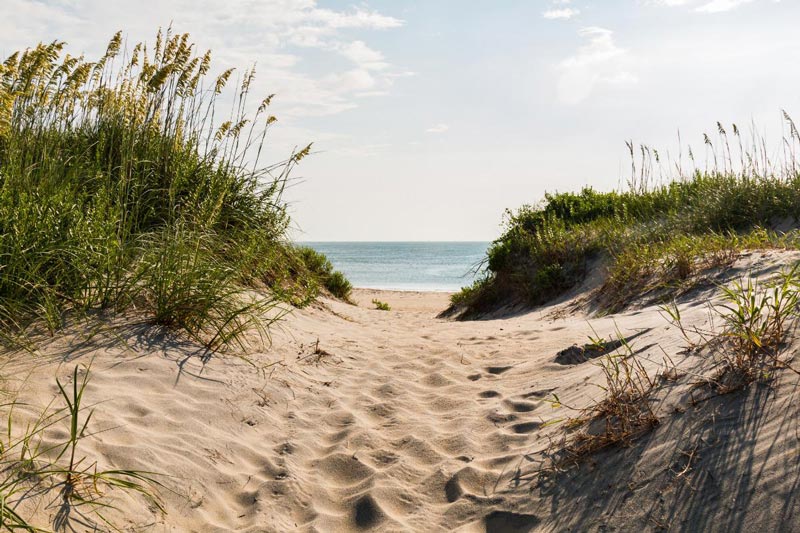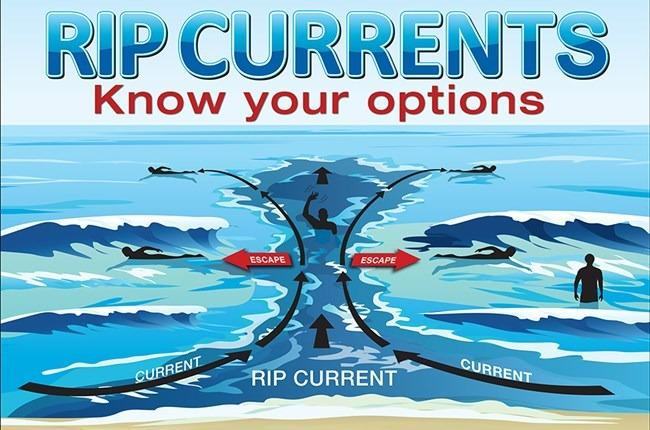
OBX Beach and Ocean Safety

Vacationing on the Outer Banks should be a fun and safe experience for everyone. If you have never been to the beaches on the Outer Banks, you may not be familiar with red flags, rip currents, and other surf hazards. Let us provide you with some tips and advice that are important to know before you go!
What are rip currents?
Rip currents are strong, narrow currents that pull away from the shore and they commonly occur in breaks in sandbars, near jetties or piers, and low spots.
A person caught in a rip current can be swept out away from the beach in a matter of seconds.
Rip currents do not pull swimmers below the water, they just pull them out.

Image courtesy of NOAA
What do I do if I am caught in one?
Most importantly stay calm, do not try to fight the current. Trying to outswim the current will wear you out even quicker.
Swim sideways, parallel to the shore. This will help you get out of the rip.
If you can't swim parallel try to calmly tread water or float. It is important to keep your head above the water. The currents strength typically weakens offshore.
If you cannot make it to shore, try to draw attention to yourself by waving your arms or yelling.
Think of rip currents as treadmills that can’t be turned off. To escape you need to step on either side of it, if you don’t it will wear you out. Remember rip currents pose a threat to even the strongest of swimmers.
What do I do if someone else is caught in a rip current?
Do not attempt to jump in to save someone stuck in a rip current unless you are trained in ocean rescue.
If you suspect someone is trapped in a rip current notify the closest lifeguard or dial 911 immediately.
If possible, throw out a flotational device for the trapped swimmer to grab on to.
How to spot a rip current
According to the National Oceanic and Atmospheric Administration, signs of rip currents include:
A channel where water is choppy and churning.
A line of seaweed, seafoam or debris moving steadily out to sea.
An unsteady pattern of incoming waves.
What do red flags mean?
Red flags flying on the beaches indicate hazardous surf conditions and swimming is prohibited.
Consequences for disobeying the no swimming or wading rules vary from town to town but in most scenarios, ocean rescue personnel will either issue warnings, tickets, and/or fines.
Ocean rescue personnel are trained individuals and the decision to fly the red flags is a serious matter.
Swimming when red flags are up put your life and lifeguards’ lives in danger.

Why are people surfing while red flags are up?
The only exception to the red flags is those surfing or bodyboarding.
Surfboards must be at least 5 feet long with a leash attached to the surfer and they must have at least one fin.
Bodyboarders need to have a durable coiled leash attached to them and be wearing fins. The bodyboard must be made up of a foam core encapsulated by a durable plastic bottom with a foam deck and side rails.
No styrofoam boards with mesh covers and woven leashes.
Only serious surfers and bodyboarders should enter the water when red flags are flying.
Failure to abide by these rules can result in tickets and/or fines.

What do yellow flags mean?
A yellow flag placed in the sand indicates a moderate risk for rip currents in that location.
Swimming is allowed but only advised for experienced swimmers.
If you have questions about the rip current risks, be sure to ask the lifeguard on duty. If you have any doubts, do not go swimming.
Where are lifeguards stationed?
If you prefer to play it safe and swim near a lifeguard, find out what beach access closest to you has a lifeguard on duty by finding your town on this chart. Lifeguards patrol the following towns seasonally, click each town to go to the town’s ocean rescue website.

How to stay safe at the beach
Never swim alone, always have a friend or someone with you.
Swim near a lifeguard.
Know where you are in case of emergency.
Have a cell phone on the beach.
Do not dive into the water.
Do not swim out too far.
Educate yourself and others of potential risks at the beach.
Check the forecast before you go.
Fill in any holes you dig to avoid injuring someone later on
If you visit the 4x4 area, please do not feed the horses, they need to stay safe too!
And to avoid forgetting something, check out our comprehensive list of what to pack in your OBX beach bag here.
To stay up to date on beach-related weather alerts from the National Weather Service and alerts from Outer Banks Ocean Rescue services text "OBXBeachConditions" to 77295
KEES cares, that’s why we want to assure everyone vacationing is prepared for and aware of ocean hazards. The ocean is beautiful and provides lots of fun to us all here on the Outer Banks but it’s important to never underestimate its capabilities! If you have any questions regarding ocean safety or risks, be sure to ask a lifeguard on duty.
